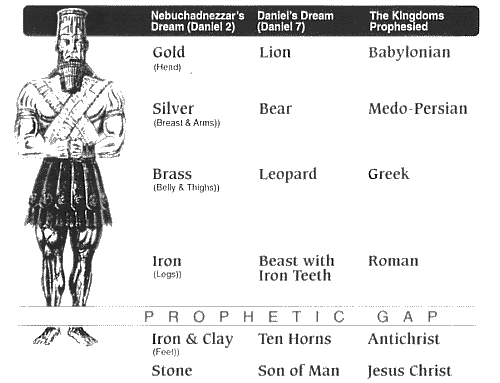Flashback to Daniel
continued from Part 1
This begs the question, “What were they expecting that made them so sure Jesus was not the Messiah?” They knew the scriptures better than anyone. After all, some of the Pharisees could even boast having memorized the entire Torah! To answer this question, I think it is important that we take a look at the foundation of all Biblical eschatology, Daniel. Daniel was written by a Hebrew captive while in exile to Babylon beginning in 605 BCE. Recall Nebuchadnezzar’s dream (Dan. 2:1) of a great statue that predicted four kingdoms which were represented by the four metals composing the statue. The most important feature is that at the end of the dream the statue is destroyed by a great stone (Dan. 2:44-45). This is what the Jews were expecting then (and now) and this is what Christians understand to be the promise of the Second Advent. Because of the mention of King Belshazzar, Nabonidus’ son and co-regent, we can determine that the book moves chronologically from chapters one to six and then at chapter seven backs up in time to a point somewhere before chapter five. What is important is that Daniel’s vision in chapter seven parallels the dream in chapter two albeit, as I will argue below, from the divine perspective rather than a human perspective.
 In biblical prophecy a “vision” is frequently the vehicle employed by God to reveal the future to His prophets. Whether earthbound or through mystical ascension to heaven, apocalyptic visions serve as means to encourage God’s people that the kingdom of God will certainly come. Usually the symbolic images are interpreted to the visionary by an angel. The ancients recognized both dreams and visions but frequently used the terms interchangeably.[i] If one accepts the inspiration of scripture, an apocalyptic vision should be interpreted as what the prophet actually saw not merely a genre of literature. Daniel chapter seven begins with the prophet lying in bed and seeing “a dream and visions of his head” (v.1). Scholars universally agree that this vision parallels the four kingdoms from Nebuchadnezzar’s dream in chapter two.[ii] However, between chapters two and seven there is a juxtaposition of imagery that speaks to a divine commentary on the vainglory of man.
In biblical prophecy a “vision” is frequently the vehicle employed by God to reveal the future to His prophets. Whether earthbound or through mystical ascension to heaven, apocalyptic visions serve as means to encourage God’s people that the kingdom of God will certainly come. Usually the symbolic images are interpreted to the visionary by an angel. The ancients recognized both dreams and visions but frequently used the terms interchangeably.[i] If one accepts the inspiration of scripture, an apocalyptic vision should be interpreted as what the prophet actually saw not merely a genre of literature. Daniel chapter seven begins with the prophet lying in bed and seeing “a dream and visions of his head” (v.1). Scholars universally agree that this vision parallels the four kingdoms from Nebuchadnezzar’s dream in chapter two.[ii] However, between chapters two and seven there is a juxtaposition of imagery that speaks to a divine commentary on the vainglory of man.
Daniel saw four great beasts rise out of the sea that later we are told represent “four kingdoms that will rise from the earth” (Dan 7:17). Conservative scholars unanimously agree that the kingdoms are Babylon, Medo-Persia, Greece, and Rome.[iii] While there are alternate interpretations, postulating Babylon, Median, Persia, Greece, I believe that only those bent by anti-supernatural bias relegate the vision to the Maccabean era by late dating the text and ascribing pseudepigraphical status. They must violate the historical record by splitting Medo-Persia into two separate empires. They then proceed to violate holy inspiration by assigning the fourth beast to the Greek Empire. They make the book a clever forgery. Because Jesus himself authenticated Daniel as the author (Mat. 24:15) this is a non starter for true Christians.
Due to my own first principles, I dismiss such biased conjecture outright. However, I will demonstrate that the traditional view is coherent with prophetic symbolism and the historical record, while the liberal critic’s position appears ad hoc and disingenuous. I also agree with H.A. Ironside, who commenting on the parallel with the chapter two statue dream writes, “In what we have already gone over we have been chiefly occupied with prophetic history as viewed from man’s standpoint; but in the second half of the book we have the same scenes as viewed in God’s unsullied light.”[iv] Daniel’s vision is illustrative of God’s view of imperialism. Contemplate the kingdom values expressed by Christ in His sermon on the mount. Then consider Nebuchadnezzar when Daniel first encountered him: proud, fierce, and ambitious. How aggrandizing it was to be represented as a head of pure gold. And isn’t this the way of us all apart from the grace of God?
The first beast that looked like a ferocious lion and represents Babylon corresponds to Nebuchadnezzar’s golden head. However, in this second vision additional details make for an apt description of Nebuchadnezzar himself. In view of chapter four’s events, the tearing off of the beast’s wings seems to symbolize Nebuchadnezzar’s humbling. When the lion-like beast is given the heart of a man, his restoration and testimony about God come to mind. The parallel is compelling. On a more earthbound note, in Nebuchadnezzar’s time the Babylonian Ishtar Gate entrance was lined with yellow lions in relief on blue-glazed brick.[v] The winged lion of Babylon was a well established emblem. One would be hard pressed to find a more fitting symbol.
The second beast is a great blood-thirsty bear raised up on one side which represents the Medo-Persian Empire. The description is subtly appropriate for a federation in which one nation dominates the other. In fact, the historical record is clear that the Persian contingent did dominate the Median. The liberal view that this beast is Median singular fails in this regard. Furthermore, the bear is divinely commanded to devour three ribs, corresponding nicely with the major three conquests made by King Cyrus and his son Cambyses: the Lydian (546 BCE), Chaldean (539 BCE) and Egyptian (525 BCE).[vi] Chapter 6 of Daniel is very plain that the kingdom at that time was the kingdom of the “Medes and Persians” (vv. 8, 12, 15). Thus the book of Daniel itself states that this was the Medo-Persian Empire at this time.[vii] The Maccabean hypothesis is incoherent in light of the evidence. This level of correspondence with verifiable history authenticates the traditional interpretation and speaks to the prophetic veracity of the vision. Yet it is a ghastly bloody scene, far removed from the shining silver of Nebuchadnezzar’s dream.
The four-winged leopard with four heads represents the Greek empire won by Alexander the Great. Like a swift and agile leopard, Alexander was famous for his expeditious conquest of the known world. Of particular interest to the biblical perspective, Josephus records that Alexander had intended to destroy Jerusalem until he recognized the purple robed high priest from his own dream about conquering Asia. The priest handed him the scroll of Daniel,
And when the book of Daniel was showed him, wherein Daniel declared that one of the Greeks should destroy the empire of the Persians, he supposed that himself was the person intended; …He granted all they desired: and when they entreated him that he would permit the Jews in Babylon and Media to enjoy their own laws also, he willingly promised to do hereafter what they desired:[viii]
Leniency aside, Alexander died at the young age of thirty-two leaving his four generals Antipater, Lysimachus, Seleucus, and Ptolemy to squabble over the empire. The biblical writers used the term “head” as a symbol for leadership and ruling authority and this neatly explains the leopard’s four heads. [ix] Again the traditional interpretation is supported by the data and the liberal view fails. Also we get a glimpse from the heavenly perspective, a carnivorous monster rather than the cast bronze of man-centered majesty.
The fourth and final terrible beast of Daniel’s night visions is one unlike any known creature. It corresponds to the iron legs, feet, and toes of Nebuchadnezzar’s statue and represents Rome. Several details tie the statue and dreadful beast together. The legs of the statue are iron like the teeth of the animal. The animal has ten horns paralleled in the ten toes of the statue, presumably representing ten kingdoms. However, a unique element not present in the dream of the statue is introduced in the vision of the four beasts: the appearance of “another horn, a little one,” which replaced three of the horns of the last and terrible beast. While the horns and toes seem to be kingdoms, this eleventh horn has eyes like a man and supplants three others. This appears to be the first biblical reference to the individual later described in the New Testament as the Antichrist. Daniel’s vision is still contemporaneously prophetic to the twenty-first century!
As a believer I take a high view of inspiration and I feel compelled to make much out of the sharp contrast between the vision given to the godly prophet and the impious king. It runs deeper than first appearance. In chapter two the interpreter is a man, Daniel. In chapter seven the interpreter is a holy angel from the divine council scene. World history from man’s perspective is triumphal idolatry, while from God’s perspective it is beastly carnage. Miller admits “there may be truth to it.” [x] Walvoord concurs, “…world history from God’s standpoint in its immorality, brutality, and depravity.” [xi] In the economy of Jesus Christ where the meek “shall inherit the earth” (Matt. 5:5), it should not be dismissed as fanciful.
To be continued…
[i]Leland Ryken, Jim Wilhoit, Tremper Longman et al., Dictionary of Biblical Imagery, electronic ed. (Downers Grove, IL: InterVarsity Press, 2000, c1998), 217.
[ii]Stephen R. Miller, vol. 18, Daniel, Includes Indexes., electronic ed., Logos Library System; The New American Commentary (Nashville: Broadman & Holman Publishers, 2001, c1994), 192.
[iii] Miller, Daniel, 196.
[iv]Henry Allan Ironside, Lectures on Daniel the Prophet., 2d ed. (New York: Loizeaux Bros., 1953), 117.
[v]Gleason L. Archer, Jr., “Daniel” In , in The Expositor’s Bible Commentary, Volume 7: Daniel and the Minor Prophets, ed. Frank E. Gaebelein (Grand Rapids, MI: Zondervan Publishing House, 1986), 85.
[vi]Archer, “Daniel”, 86.
[vii]John F. Walvoord, Daniel: The Key To Prophetic Revelation (Galaxie Software, 2008; 2008), 148.
[viii]Flavius Josephus and William Whiston, The Works of Josephus : Complete and Unabridged, Includes Index. (Peabody: Hendrickson, 1996, c1987), Ant 11.337-338.
[ix] Ryken, Wilhoit, Longman et al., Dictionary of Biblical Imagery, 368.
[x]Miller, Daniel, 218.
[xi]Walvoord, Daniel, 151.




